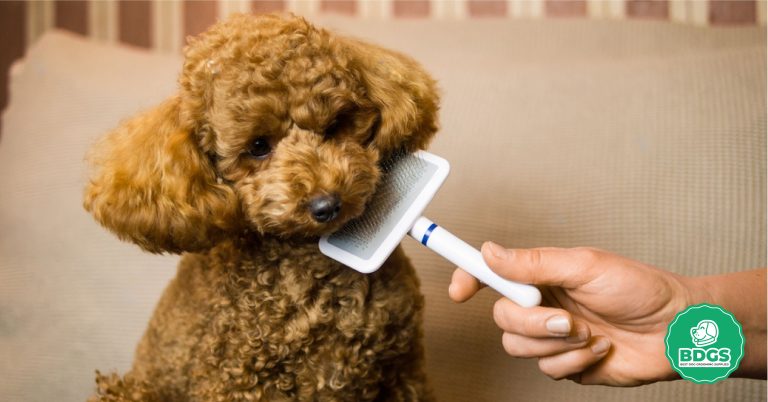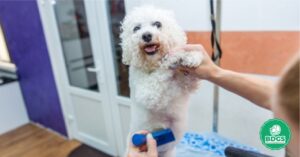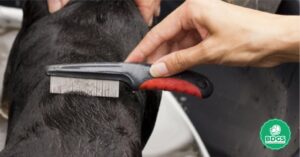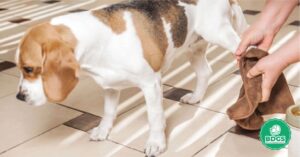Grooming your dog is essential to keeping them healthy and happy. The dog grooming brush is one of the most important things you need to groom your dog. You can use these brushes like magic wands on your dog’s fur to keep it clean, smooth, and looking its best.
You can gently remove dirt, loose fur, and mats from your dog’s body with a brush. Brushing your dog regularly does more than make them look nice. It also keeps their skin healthy and reduces shedding, making your life easier.
We’ll discuss the different dog grooming brushes and their use in this guide. We will help you pick the best brush for your dog, no matter what type of hair it has (long, short, or somewhere in between). If you know what you’re doing and have the right tools, brushing your pet will be a breeze for both of you. Let’s learn more about dog grooming brushes and keep those tails moving!
What are the different dog coat types for dog grooming brushes?
Yes, I’d be happy to talk about the different kinds of dog coats and the dog grooming brushes that work best with each one:
- Smooth Coats: Smooth-coated dogs have short, smooth fur that stays close to their bodies. These are the types of dogs that belong to this group. A hair brush is the best type of brush for these coats. It keeps the skin shiny, removes free hair, and spreads natural oils around.
- Double Coats: Some dog breeds, like Huskies and Golden Retrievers, have two coats: a thick undercoat and guard hairs that are longer. A slicker brush or a hair rake is an excellent way to get rid of a free undercoat and keep it from sticking.
- Long Coats: There are certain things that Afghan Hounds and Shih Tzu need that other dogs don’t. A pin brush or a combination brush with long, soft bristles will help keep long coats from getting tangled and matted.
- Wire Coats: Terrier breeds have scratchy, thick fur that needs to be brushed often. Slicker or pin brushes can help keep the smoothness and eliminate free hair in wire coats.
- Curly or Woolly Coats: Brush it often if you want to keep your Poodle or Bichon Frise’s hair in good shape. A slicker brush and a comb are suitable for keeping the curls in place and the hair from sticking.
- Short Coats: Caring for the short, thick fur of breeds like Beagles and Bulldogs is easy. If you want to eliminate free hair and touch your skin, a rubber curry brush or a grooming mitt is a good choice.
- Hairless Breeds: The Chinese Crested breed doesn’t have hair and needs special care when groomed. A soft brush and sunscreen should gently scrub these dogs’ skin.
Remember, using the right dog grooming brush for your dog’s coat type is essential to keep them healthy and looking good. Brushing your pet’s fur daily keeps it looking great and strengthens the bond between you and your fuzzy friend.
What is the Dog Shedding Level for dog brushes?
The amount a dog sheds depends significantly on the breed and the dog itself. It is very important to pick the right dog grooming brush based on how much your dog sheds. Here is a list of the brushing brushes that go with each amount of shedding:
- Low Shedders: Poodles, Bichon Frises, and Basenjis are breeds that don’t shed much. A slicker brush or a pin brush will work for these dogs. Brushing your cat often keeps it from getting mats and reduces the amount of hair it sheds.
- Moderate Shedders: Here are a lot of well-known dog types, like Labrador Retrievers, Beagles, and Boxers. To keep your dog from shedding, use a slicker brush, a de-shedding tool, or an undercoat rake to remove loose fur in the undercoat.
- Heavy Shedders: Lots of hair comes from dogs like Huskies, German Shepherds, and Golden Retrievers, significantly when the seasons change. If your dog sheds a lot, you need an excellent de-shedding tool. With these tools, you can get rid of loose base hair and lessen shedding.
- Non-Shedders/Hypoallergenic Breeds: Poodles (standard, miniature, and toy), Bichon Frises, and Maltese are some of the dog breeds that don’t shed and are suitable for people with allergies. These dog types don’t shed but must be brushed regularly to keep them from getting matted. You can use a pin brush or a slicker brush for their thin fur.
- Hairless Breeds: Dogs that don’t have hair, like the Chinese Crested, need special care to keep their skin clean. To remove dead skin cells, use a soft scrubbing brush or brush mitt. Also, put sunscreen on them before going outside to protect their skin.
You must know how much it sheds to choose the right brush for your dog. Grooming your dog regularly keeps his hair healthy and comfy and stops him from shedding. A professional groomer or your vet is the best person to talk to if you’re unsure what your dog needs.
What is the Dog Skin Sensitivity for pet grooming brushes?
To keep your dog from getting hurt or irritated, you should know how sensitive their skin is before picking out a brush. Here’s a breakdown of dog skin sensitivity levels and the related brushes:
- Low Skin Sensitivity: Skin that doesn’t itch or hurt dogs is usually challenging and durable. Slicker brushes, pin brushes, and plastic curry brushes are just a few of the ones that can be used. These brushes work well for daily scrubbing and help keep the coat in good shape.
- Moderate Skin Sensitivity: A lot of dogs in this group have skin that is only slightly sensitive. A pin brush or slicker brush with soft bristles usually works well. With these brushes, you can get a good clean without any pain.
- High Skin Sensitivity: Some dogs’ skin is more delicate and can get hurt easily. The best brush for dogs with susceptible skin is a soft-bristle brush or a brush glove. There is a slight chance these brushes will irritate your skin because they are soft.
- Skin Conditions or Allergies: Taking extra care of dogs with skin problems or allergies is essential. Talk to your vet or a professional groomer about which brushes and other brush tools will work best for your pet’s skin. A neutral or medicinal choice may be suggested.
- Hairless Breeds: Hairless breeds like the Chinese Crested need to be groomed gently to keep their skin from getting hurt. For sensitive skin, use soft brushes or grooming gloves. Protect their skin with sunscreen when they’re brushing outside.
No matter how sensitive your dog’s skin is, it would help if you always gently brush them. Watch how your dog reacts, and stop if they show signs of being upset or uncomfortable. Grooming your dog regularly and being gentle is good for skin and hair.
What is the budget for dog brushes?
Dog grooming brushes can cost a lot of different amounts of money, depending on the brand, type, and quality of the brush. You can expect to spend the following amounts on different types of dog care brushes:
Basic Brushes:
- Budget Range: $5 to $15
- These are the cheapest brushes you can get. Examples are rubber curry brushes or slicker brushes with simple shapes and materials. They’re suitable for regularly brushing yourself.
Mid-Range Brushes:
- Budget Range:$15.00 to $30.00
- These brushes are usually of higher quality and last longer. In this range, you’ll find slicker brushes, pin brushes, and de-shedding tools with handles that are better shaped for comfort.
Specialized Brushes:
- Budget Range: $30 to $60
- This group includes specialized brushes like high-quality de-shedding tools or brush gloves for different hair types. They might have unique traits that help them be groomed well.
Professional-Grade Brushes:
- Budget Range: $60 or more
- Professional groomers can buy high-end grooming tools that are made to last and have advanced features. Most of the time, these brushes cost more, but they work very well.
Before buying a brush, you should consider what your dog needs, like what kind of coat they have and how sensitive they are. Depending on your budget, buying a good brush that fits your dog’s needs can make brushing more manageable and effective. Also, brushing and maintaining your grooming tools regularly can help them last longer, saving you money in the long run.
What is the ease of use for dog grooming brushes?
How easy dog grooming brushes are to use depends on several things, such as how they are designed and how much you know about grooming. The following list shows how easy it is to use different kinds of grooming brushes:
- Slicker Brushes: Most dog owners find slicker brushes easy to use. They have fine wire brushes that are good at removing mats and tangles. But be careful not to hurt your skin when you use them.
- Pin Brushes: Pin brushes with pins that have smooth tips are usually simple to use. You can brush your dog with them daily, and they’re comfortable for both of you.
- Bristle Brushes: Soft or medium-sized bristle brushes are simple to use. It’s easy for natural oils to spread through their coat, and the skin will look shiny.
- De-shedding Tools: De-shedding tools work, but you must be careful to use them sparingly. They are easy to put on the finish to stop it from shedding, but be careful around sensitive areas.
- Grooming Mitts: Grooming mitts are easy to use, and give your pet a gentle rub while you clean them. They work for all dog sizes and types of coats.
- Rubber Curry Brushes: This rubber curry brush is easy to use and works well for dogs with short hair. For successful cleaning, they are usually used in a circle.
- Undercoat Rakes: You need to know how to use an undercoat rake correctly to get to the undercoat. You can use them on breeds with double coats, but it might take a while to get good at it.
- Grooming Combs: Grooming combs are simple tools that can be used to remove loose hair and untangle hair. They work well on different kinds of coats.
- Specialized Brushes: Some brushes, like those made for de-matting or certain types of coats, may need more care and skill when handled.
Remember that how easy it is to use depends on how your dog acts. If you have never groomed your dog, start slowly and use positive feedback to make it fun. Grooming your dog regularly can help you get used to the process over time.
What is the purpose of a dog grooming brush?
A dog brush keeps your dog’s fur clean, healthy, and in good shape. What a dog brush is mainly used for and why it’s useful:
- Remove Loose Fur: Grooming brushes can help remove your dog’s dead and loose hair. This makes your dog more relaxed and stops them from shedding too much around the house.
- Prevent Matting: Brushing your dog’s fur regularly can help keep it from getting tangled and matted. Your pet may feel pain and discomfort from the mats.
- Distribute Natural Oils: Brushing your dog’s fur helps distribute the natural oils made by his skin throughout the hair, making it look healthy and shinier.
- Stimulate Skin Health: Brushing your hair improves your skin’s health by increasing blood flow and removing dirt, debris, and acne.
- Bonding Time: Grooming lessons allow you and your dog to get closer. The experience could be excellent and fun for both of you.
- Spot Skin Issues: Brushing your dog regularly will help you find any lumps, bumps, or skin problems early on, which is good for their health.
- Remove Allergens: Brushing your dog can help remove allergens like pollen and dust from its fur, which is suitable for people in your home who have allergies.
- Maintain Coat Texture: Different coats need different cleaning brushes to maintain color and texture.
- Reduce Odor: Brushing your dog’s fur can help remove dirt and other things that cause bad smells, keeping them feeling clean.
- Prepare for Bathing: Brushing your hair before a bath can help remove loose hair and improve the tub.
- Enhance Appearance: Grooming brushes help your dog look its best, whether you’re grooming it for a show or to keep it neat.
To sum up, a dog brush is essential for keeping your dog healthy and looking good. You and your dog will feel closer to each other and be cleaner and more comfortable after being brushed regularly.
What are the drawbacks of dog grooming brush?
Grooming brushes for dogs are essential for keeping your pet’s hair and health in good shape, but there are some things you should know about them:
- Skin Irritation: Some brushes can hurt your dog’s skin if you don’t use them properly, especially if they have sensitive skin. When meeting, it’s essential to be kind and careful.
- Over-Grooming: If you brush your dog too hard or too often, you may be over-grooming, damaging the hair and making your dog uncomfortable.
- Matting or Tangling: It can be hard to clean your dog if you brush it infrequently or use the wrong type of brush for its hair. Matting and sticking can also happen.
- Fear or Anxiety: Some dogs may get scared or nervous when being groomed, especially if they have had bad situations. You need to be patient and give good feedback.
- Bristle Shedding: Some cleaning brushes have hairs that fall off over time. This can be annoying; if your dog eats them, they could be harmful.
- Ineffective for Heavy Shedders: Grooming brushes can help cut down on shedding, but they might not work as well for dogs that shed a lot, which would need extra tools like de-shedding combs.
- Cost: Good cleaning brushes can be pricey, and buying several of them for different types of coats can add up.
- Time-Consuming: It can take a lot of time to groom your dog correctly, some breeds may need to be groomed more often than others.
- Resistance: If your dog isn’t used to being groomed, it might fight back or not cooperate during lessons, which can be challenging for both of you.
- Allergies: If you have allergies, you should be careful when brushing your dog because you could be exposed to allergens like hair and dust.
- Maintenance: Grooming brushes must be cleaned and cared for regularly to keep dirt, hair, and germs from building up.
Even though these things could go wrong, the pros of regular and proper brushing far outweigh the cons. Picking the suitable encounter for your dog’s coat type is very important. Be gentle and patient when brushing; talk to a professional groomer or doctor if you have any problems or concerns.
Buyer Guides: How to Buy a Dog Grooming Brush
Of course! This guide will help you pick the best dog grooming brush:
1. Understand Your Dog’s Coat Type:
Find out what kind of coat your dog has before you buy a brush. What length is it? Is it curly, stiff, or two coats? Every type of coat needs a different kind of brush.
2. Choose the Right Brush Type:
- Slicker Brushes: With a slicker brush, you can eliminate knots, mats, and loose fur. Great for all kinds of coats.
- Pin brushes are soft enough to use daily and can be used on coats of different lengths.
- Bristle brushes are the best way to spread natural oils and make the coat shine.
- Deshedding Tools: These reduce shedding in dogs with two coats.
- Grooming mitts are comfortable and can be used on a variety of skins.
- Rubber curry brushes are great for massaging and brushing short-haired dogs.
- Undercoat Rakes: For dogs with two coats, hair rakes help get rid of loose fur.
- Specialized Brushes: For specific tasks, pick de-matting brushes or flea combs.
3. Consider Your Dog’s Sensitivity:
Stick with brushes that have soft bristles or rubber tips if your dog has sensitive skin.
4. Check Handle Comfort:
Ensure the brush handle fits comfortably in your hand, especially if you plan to use it for a long time.
5. Quality Matters:
Buy a good brush made of long-lasting materials to ensure it works well and lasts a long time.
6. Read Reviews:
Do some research on the brush you want to buy and read reviews from other customers to get an idea of how well it works and how long it lasts.
7. Seek Professional Advice:
Check with a professional groomer or your vet if you need help deciding which brush to pick.
8. Consider Your Dog’s Size:
Please make sure that the brush is the right size for your dog. Smaller meetings work best for small-breed dogs, while bigger brushes work better for larger dogs.
9. Ease of brushing:
To keep hair and germs from building up, look for brushes that are easy to clean.
10. Budget Considerations:
Quality is essential, but you should also think about your income. There are brush tools that cost a range of amounts.
11. Ask for a Demo:
Ask someone at a pet shop or a professional groomer to show you how the brush works.
12. Test Sensitivity:
Before you do a lot of brushing on your dog, test how sensitive the brush is on a small area of its fur to ensure it doesn’t hurt or irritate it.
13. Positive Reinforcement:
When you clean your dog, use treats and praise as positive feedback to make the process fun for him.
Remember that brushing your dog regularly is essential for its health and happiness. Getting the right brush for your pet can make the process fun for both of you and keep your body in great shape.
Conclusion
Finally, picking the right dog grooming brush is essential to keeping your pet healthy and happy. You should know your dog’s unique coat type, level of sensitivity, and brush before choosing.
There is a brush tool for every type of dog, whether it’s a short-haired breed that does better with a rubber curry brush or a long-haired friend with a pin brush or slicker brush. When choosing, the most important things to you should be quality, comfort, and ease of use.
Asking professionals for help, reading reviews, and thinking about your budget will also help you find a brush that works well for you and your dog. Remember that brush sessions aren’t just about keeping your pet looking good but also about getting closer to your beloved dog. With the right brush, you can keep your dog’s fur clean, free of tangles, and healthy, improving their life.
Frequently Asked Questions
The type of dog’s coat and how it needs to be groomed determine the brush used. Slicker brushes, pin brushes, bristle brushes, de-shedding tools, and specialty brushes like de-matting combs are all common. Whatever brush you choose for your dog will depend on its breed, coat length, and any special needs it may have.
Most of the time brushes with soft bristles or rubber tips won’t hurt dogs. Dogs’ skin doesn’t get hurt when using slicker brushes or pin brushes with rounded or covered pins correctly. Some hair brushes, grooming mitts, and rubber curry brushes are also made to be gentle and comfy for dogs while they are being groomed.
A de-shedding tool or a hair rake is the best way to remove a dog’s fur. With these tools, you can get to the thick layer, especially for dogs with two coats, and remove any free skin. When used right, they help keep the hair from getting matted or tangled and cut down on shedding.
Most of the time, a slicker brush and a pin brush together are the best brush for a dog with long hair. Start using a slicker brush to remove knots and mats gently. After that, use a pin brush to remove more knots, spread the natural oils, and make the coat shiny. Long-haired dog types may also benefit from extra-long pin brushes and other brushes made just for long hair. Using these brushes to clean your dog regularly helps keep their long coat healthy and beautiful.













